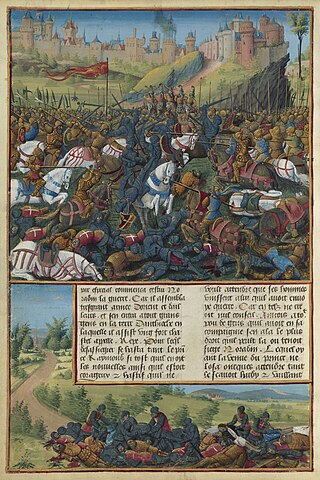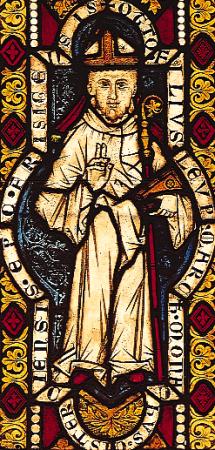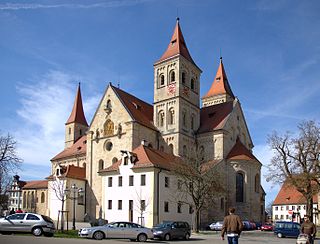Related Research Articles

Theophanu was empress of the Holy Roman Empire by marriage to Emperor Otto II, and regent of the Empire during the minority of their son, Emperor Otto III, from 983 until her death in 991. She was the niece of the Byzantine Emperor John I Tzimiskes. Theophanu was known to be a forceful and capable ruler, and her status in the history of the Empire was in many ways exceptional. According to Wilson, "She became the only consort to receive the title 'co-empress', and it was envisaged she would succeed as sole ruler if Otto II died without a son."

The Holy Roman Emperor, originally and officially the Emperor of the Romans during the Middle Ages, and also known as the Roman-German Emperor since the early modern period, was the ruler and head of state of the Holy Roman Empire. The title was held in conjunction with the title of king of Italy from the 8th to the 16th century, and, almost without interruption, with the title of king of Germany throughout the 12th to 18th centuries.

Widukind of Corvey was a medieval Saxon chronicler. His three-volume Res gestae Saxonicae sive annalium libri tres is an important chronicle of 10th-century Germany (Germania) during the rule of the Ottonian dynasty.

The Second Crusade (1147–1150) was the second major crusade launched from Europe. The Second Crusade was started in response to the fall of the County of Edessa in 1144 to the forces of Zengi. The county had been founded during the First Crusade (1096–1099) by King Baldwin I of Jerusalem in 1098. While it was the first Crusader state to be founded, it was also the first to fall.

Otto of Freising was a German churchman of the Cistercian order and chronicled at least two texts which carries valuable information on the political history of his own time. He was the bishop of Freising from 1138. Otto participated in the Second Crusade; he lived through the journey and reached Jerusalem, and later returned to Bavaria in the late 1140s, living for another decade back in Europe.
Bernold of Constance was a chronicler and writer of tracts, and a defender of the Church reforms of Pope Gregory VII.

The Kingdom of Germany or German Kingdom was the mostly Germanic language-speaking East Frankish kingdom, which was formed by the Treaty of Verdun in 843. The king was elected, initially by the rulers of the stem duchies, who generally chose one of their own. After 962, when Otto I was crowned emperor, East Francia formed the bulk of the Holy Roman Empire, which also included the Kingdom of Italy and, after 1032, the Kingdom of Burgundy.
Saint Blaise was a physician and bishop of Sebaste, martyred in 316.

Solomon, also Salomon was King of Hungary from 1063. Being the elder son of Andrew I, he was crowned king in his father's lifetime in 1057 or 1058. However, he was forced to flee from Hungary after his uncle, Béla I, dethroned Andrew in 1060. Assisted by German troops, Solomon returned and was again crowned king in 1063. On this occasion he married Judith, sister of Henry IV, Holy Roman Emperor. In the following year he reached an agreement with his cousins, the three sons of Béla I. Géza, Ladislaus and Lampert acknowledged Solomon's rule, but in exchange received one-third of the kingdom as a separate duchy.
John of Viktring was a late medieval chronicler and political advisor to Duke Henry of Carinthia.

Ellwangen Abbey was the earliest Benedictine monastery established in the Duchy of Swabia, at the present-day town of Ellwangen an der Jagst, Baden-Württemberg, about 100 km (60 mi) north-east of Stuttgart.

Saint Blaise Abbey was a Benedictine monastery in the village of St. Blasien in the Black Forest in Baden-Württemberg, Germany.

The Battle of Monte Porzio was fought on 29 May 1167 between the Holy Roman Empire and the Commune of Rome. The communal Roman army, which one historian has called the "greatest army which Rome had sent into the field in centuries", was defeated by the forces of the Emperor Frederick Barbarossa and his local allies, the Counts of Tusculum and the ruler of Albano. Comparing its effect on the city of Rome, one historian has called Monte Porzio the "Cannae of the Middle Ages".

St. Blasien is a small town located in the Waldshut district in Baden-Württemberg, Germany. It is situated in the Southern Black Forest, 17 km northeast of Waldshut-Tiengen.
Boris, also known as Boris Kalamanos was a claimant to the Hungarian throne in the middle of the 12th century. He was the son of Euphemia of Kiev, the second wife of Coloman the Learned, King of Hungary. After Euphemia was caught in adultery, Coloman expelled her from Hungary and never acknowledged that he was Boris's father. However, Boris, who was born in the Kievan Rus', regarded himself as the king's lawful son. He laid claim to Hungary after Coloman's firstborn and successor, Stephen II of Hungary, died in 1131. Boris made several attempts to assert his claims against kings Béla II and Géza II with the assistance of Poland, the Holy Roman Empire and the Byzantine Empire, but failed and was killed in a battle.

The Annales laureshamenses, also called Annals of Lorsch (AL), are a set of Reichsannalen that cover the years from 703 to 803, with a brief prologue. The annals begin where the "Chronica minora" of the Anglo-Saxon historian Bede leaves off—in the fifth year of the Emperor Tiberios III—and may have originally been composed as a continuation of Bede. The annals for the years up to 785 were written at the Abbey of Lorsch, but are dependent on earlier sources. Those for the years from 785 onward form an independent source and provide especially important coverage of the imperial coronation of Charlemagne in 800. The Annales laureshamenses have been translated into English.

Henry II, also known as Saint Henry, Obl. S. B., was Holy Roman Emperor from 1014. He died without an heir in 1024, and was the last ruler of the Ottonian line. As Duke of Bavaria, appointed in 995, Henry became King of the Romans following the sudden death of his second cousin, Emperor Otto III in 1002, was made King of Italy in 1004, and crowned emperor by Pope Benedict VIII in 1014.

The flag of the Holy Roman Empire was not a national flag, but rather an imperial banner used by the Holy Roman Emperor; black and gold were used as the colours of the imperial banner, a black eagle on a golden background. After the late 13th or early 14th century, the claws and beak of the eagle were coloured red. From the early 15th century, a double-headed eagle was used.

The Prince-Bishopric of Freising was an ecclesiastical principality of the Holy Roman Empire from 1294 until its secularisation in the early years of the 19th century.
Gervasius was a Hungarian prelate who served as Bishop of Győr from 1156 to 1157 or 1158.
References
 This article incorporates text from a publication now in the public domain : Herbermann, Charles, ed. (1913). "Otto of St. Blasien". Catholic Encyclopedia . New York: Robert Appleton Company.
This article incorporates text from a publication now in the public domain : Herbermann, Charles, ed. (1913). "Otto of St. Blasien". Catholic Encyclopedia . New York: Robert Appleton Company.
- Notes